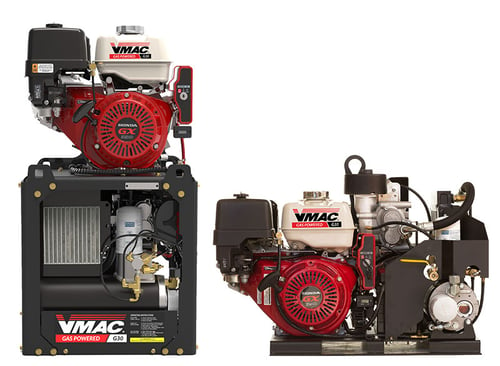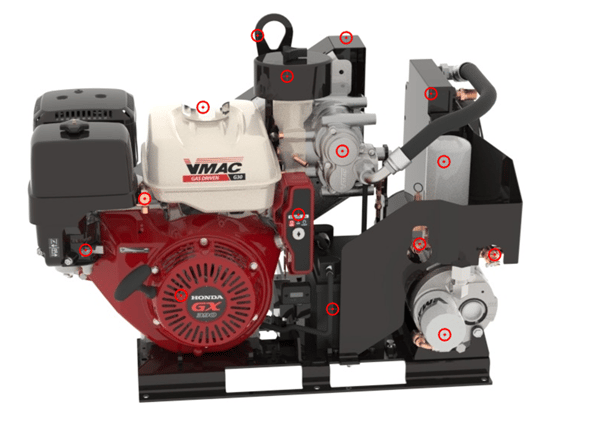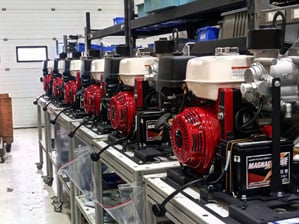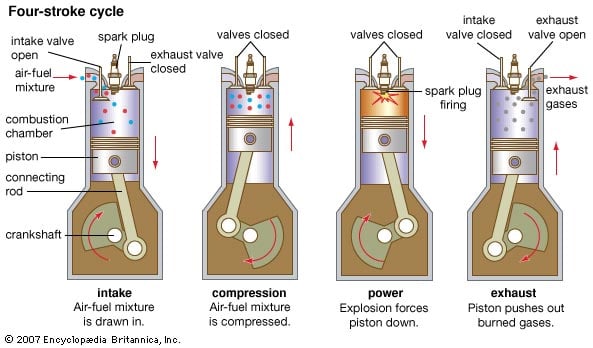How Do Gas Air Compressors Work?
Gas air compressors are straightforward, gasoline-powered air compression systems with several important components. To understand how gas air compressors work, we need to understand the components working together. Although the individual components will vary between air compressor systems, every gas air compressor has two key components:
- Air end
- Gas engine
The air end is the part of the air compressor that compresses air. The air end draws atmospheric air into the compression chamber, which is then forced into a compact space. It’s this act of forcing air molecules closer together that compresses air.
The air end includes rotors and a rotor housing in rotary screw air compressor designs and pistons in reciprocating air compressor designs.
An Example Gas Air Compressor
VMAC’s G30 air compressor comes in two configurations—standard or stacked—and looks like this:

- While these two air compressors look quite different, they have very similar components. It’s simply the arrangement of these components that results in the air compressor’s appearance.
By taking apart one of these systems, we can get a better understanding of what is happening within a gas air compressor system:

Each component plays a vital role in the air compressor system. From left to right, the identified components are:
| Component | Purpose |
|---|---|
| Fuel Supply | On/off mechanism for the fuel supply, which uses a carburetor to provide fuel to the gas engine on demand |
| Engine Throttle Control | Increases and decreases engine speed in response to air demand and is actuated by air pressure |
| Engine | Drives the compressor via belt and pulleys |
| Fuel Tank | Holds the fuel (regular grade gasoline) |
| Lifting Hook | Provides a safe connection point for a crane or hoist when mounting or removing the system |
| Compressor Air Filter | Filters particulates in the air before the air is compressed |
| Electronic Key Switch | Powers the system on and off |
| Battery | Provides electrical current for the electric starter on the engine as well as electrical components in the compressor system |
| VMAC Air End | Compresses air |
| Belt-Drive System | Gearless, clutchless auto-tensioned serpentine belt that connects air end to engine |
| Air Outlet | ½” outlet for compressed air to leave the system |
| VMAC WHASP Tank | Patented technology that separates oil and air and cools oil and air |
| Coalescing Filter | Removes oil aerosols from compressed air |
| Oil Filter | Filters contaminants in the compressor oil |
| Unloader | Decreases engine load, lowers sound levels, and reduces fuel use and engine load; set to open when the compressor develops the maximum regulated air pressure and delivers air pressure to the throttle control to reduce engine speed |
How Does A Small 4 Stroke Gas Engine Work?
 Four stroke gas engines, like the Honda GX390 used in VMAC’s gas air compressor, are spark combustion engines that convert fuel into mechanical energy. Four stroke engines utilize a simple four step process:
Four stroke gas engines, like the Honda GX390 used in VMAC’s gas air compressor, are spark combustion engines that convert fuel into mechanical energy. Four stroke engines utilize a simple four step process:
- Intake stroke
- Compression stroke
- Power stroke or expansion stroke
- Exhaust stroke
These four strokes are continually repeated while the engine runs and fuel is available. A drivetrain, comprised of pulleys, a belt and a tensioner, connects the engine to the rest of the air compressor system and drives motion. Together, the engine and the drivetrain may be referred to as the powertrain.

Source: Britannica.com
Intake Stroke
During the intake stroke, the intake valve opens, allowing fuel and air into the compression chamber. A carburetor controls the amount of fuel and air released, ensuring the right mix enters the system. While this happens, the piston lowers, creating a natural vacuum that sucks the mixed fuel and air into the cylinder. The piston is at its lowest point to make space for the air and fuel.
Compression Stroke
As the compression stroke begins, the inlet valve closes. The piston then compresses the fuel and air mixture within the engine cylinder by reducing available space. At the end of the compression stroke, when the mixture is in its most condensed state, a spark plug produces a spark.
Power Stroke / Expansion Stroke
The spark ignites the mixture, resulting in combustion. This miniature explosion pushes the piston to the bottom of the cylinder. Combustion transforms fuel energy into mechanical energy, which powers the air compressor system.
Exhaust Stroke
Exhaust is a natural byproduct of combustion and needs to be removed from the cylinder. During the exhaust stroke, the exhaust valve opens, and the piston pushes the exhaust out of the engine.
Cooling & Oil Filtering In Gas Air Compressors
Cooling
Compressing air naturally generates a lot of heat, and cooling is necessary for all air compressors. Several standard air compressor cooling methods are available, including natural air convection, liquid cooling, air-to-liquid heat exchanging, and liquid-to-liquid heat exchanging.
However, gas air compressors tend to use one of two cooling methods. Reciprocating gas air compressors typically use natural air convection, with cooling fins that help keep the air compressor cool. Meanwhile, gas air compressors with rotary screws typically use an air-to-liquid heat exchanger.
Oil Filtering
Most rotary screw gas air compressors are oil-injected, relying on oil to lubricate the system. However, this oil must be filtered and separated from the air before the air exits the system.
Oil filters filter out particulates in the compressor oil, such as dust, dirt, and material from wear and tear. Filtering these contaminants prevents them from recirculating through the compressor system, extending compressor life.
Coalescing filters remove any remaining oil mist from the compressed air stream, recycling it back into the air compressor system and preventing compressor oil from exiting the system and reaching the air tools.
Combined Cooling & Oil Filtering
VMAC has designed a proprietary Waste Heat Air Separation Package (WHASP) for its G30 gas powered air compressor that addresses both cooling and filtering at once. The WHASP includes a radiator-style cooler and fan to reduce heat. It also uses turbulence and obstacles to condense oil from the air-oil mixture, and then employs a coalescing filter to capture any remaining oil droplets.
—
Want to learn more about air compressors? View VMAC’s Guide To Rotary Screw Air Compressors!
